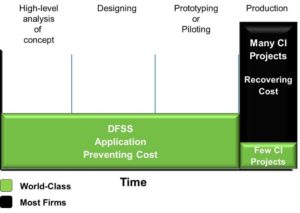
07 May Design for Six Sigma – The Next Big Thing in Continuous Improvement
Today, lean six sigma, lean and six sigma are the dominant process improvement methodologies. And for very good reason. They are very effective in fixing process issues. Specifically, six sigma focuses on variation reduction, while lean focuses on waste reduction. Lean six sigma, of course, focuses on both rather than an either-or strategy. Which methodology works best depends upon the type of processes and problems that the organization has. But all of these methodologies have a failing. They fix the problems after the fact; they are reactive in nature. While it is better to fix a problem than not, even better is not to have had the problem in the first place.
That is what Design for Six Sigma is all about. It is a methodology that shifts from fixing problems to preventing problems. It is done by improving the way organizations design products, processes or services. It is a proactive, preventive way to run the organization, which means it is a more cost-effective way to operate an organization. Problems with products, services or processes results in:
- Incurring cost to inspect/audit to find them
- Reduced customer satisfaction and lost customers
- The cost of remediating problems (e.g., compensating customers or scrapping product)
- Slower cycle times and increases in workload
- Etc.
Design for Six Sigma allows the organization to avoid these costs and become more profitable. Because it is far cheaper to design the product, process or service correctly than to fix it later. The trick is to be able to identify design shortcomings during development, before launch. In other words, when a problem exists, it is easy to see. It is hard to see what the potential problems are and design them out in a proactive and preventive fashion.
To do this, Design for Six Sigma uses a very comprehensive set of tools that fit into the DCDOV methodology, which stands for define, concept, design, optimize and verify. This methodology not only make the organization more profitable through reduced process issues, it offers multiple other benefits, such as:
- Design of products, services and processes often becomes cheaper because most issues are identified early in the design process when they are cheaper to fix.
- The product development cycle time often becomes shorter, because there is less redesign later in the design process.
 Forward thinking organizations are re-aligning their continuous improvement (CI) resources toward design for six sigma. The end result, over time, will be a CI organization that will evolve to become like the one below. Most CI will be dedicated to preventing problems (Design for Six Sigma) and many fewer to fixing them (they will no longer be needed).
Forward thinking organizations are re-aligning their continuous improvement (CI) resources toward design for six sigma. The end result, over time, will be a CI organization that will evolve to become like the one below. Most CI will be dedicated to preventing problems (Design for Six Sigma) and many fewer to fixing them (they will no longer be needed).
If an organization desires a leadership position in process performance and profitability, then Design for Six Sigma is something that leadership needs to gaining an understanding of consider implementing. Sticking with solving problems rather than preventing them is, over time, going to be a failed strategy.



